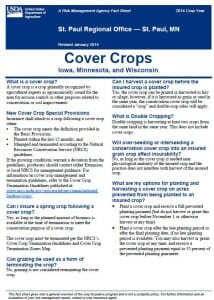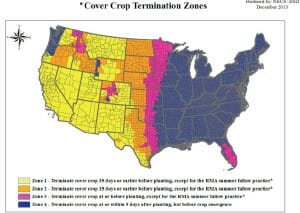Cover Crops & Crop Insurance News Items
The regional Risk Management Agency for Iowa, Minnesota and Wisconsin in St. Paul, MN just released documents to further clarify how to best insure your corn, soybeans or other cash crops following a cover crop. New information shows that grazing livestock on a cover crop or harvesting that cover crop for silage or hay while not counting as “termination” allows your following cash crop to be fully insurable. A cover crop only falls into the double crop category if cover crop seed is harvested for grain and then a 2nd crop is planted. In this scenario the cover crop seed is the first crop and the 2nd crop would be insurable at a reduced rate depending on your crop insurance policy. Cover crops need to be terminated based on the NRCS’ Cover Crop Termination Guidelines. Cover crop termination is considered by herbicide or tillage.
Cover Crops: Iowa, Wisconsin, Minnesota RMA Fact Sheet 
So what does that mean for my farm?
Scenario 1: Tama County, IA (blue county, Zone 4) fall planted winter rye cover crop; cow calf graze cover crop the following spring; no-till plant soybeans into cover crop; no herbicide used
***soybeans would NOT be insurable; The cover crop must be “terminated” by tillage or an herbicide. Grazing or haying does NOT count as termination.
Corrected Scenario 1: Tama County, IA (blue county Zone 4) fall planted winter rye cover crop; cow calf graze cover crop the following spring; no-till plant soybeans into cover crop; no herbicide used applied herbicide to the cover crop three days following soybean planting. (Note because Tama county is in a “blue” zone 4 county the cover crop can be “terminated” 5 days following soybean planting or if no-till add 7 extra days if soybeans haven’t emerged.)
Scenario 2: Lyon County, IA (pink county, Zone 3) fall planted winter wheat and hairy vetch cover crop; cover crop lightly tilled in the morning; corn planted in the afternoon.
****Corn crop is fully insurable. Cover crops in a “pink” county need to be terminated by the day of cash crop planting. If using no-till then cover crop could be killed 7 days later. Termination is by tillage or an herbicide.
Multiple other scenarios exist. Ask Duane Voy, RMA at PFI’s upcoming Annual Conference January 24-25, 2014 in Ames, IA.
To learn about more insuring a cash crop after using cover crops listen to Cover Crops and Crop Insurance, What’s the Connection webinar on January 23, 2014 1pm-2pm CENTRAL time. Read more here. Speakers include:
Rob Myers, Regional Director of Extension Programs for the North Central Sustainable Agriculture Research and Education (SARE) Program, will introduce the topic by providing background on cover crop use and the need for termination policy change.
Tim Hoffmann, Director of Product Administration and Standards Division with the USDA Risk Management Agency (RMA), will discuss the policy as it relates to crop insurance coverage and compliance.
Norm Widman, National Agronomist with the Natural Resources Conservation Service (NRCS), will walk participants through the new guidelines and how they implicate existing conservation practices.
Jeff Schahczenski, Agriculture Policy and Funding Research Director with the National Center for Appropriate Technology (NCAT), will kick off the extensive question and answer period by addressing some specific issues with the new policy’s impact on grain farmers in the Great Plains, where wheat-fallow rotations remain a persistent practice.
Ferd Hoefner, NSAC Policy Director, and Sophia Kruszewski, NSAC Policy Specialist, will be on hand to moderate questions.

